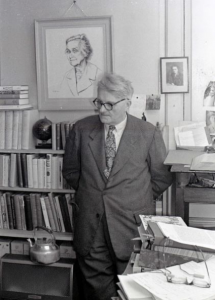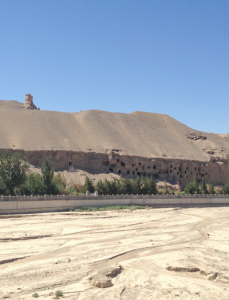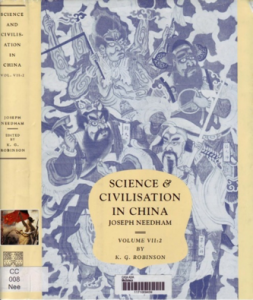Steve Bale lives in central Beijing and on the north Norfolk coast. He first travelled to China in 1988 and has been helping his clients build brands there since 1997. Many of Steve’s photographs and stories are on his website www.ChineseCurrents.com

Mention ‘China’ and ‘science and technology’ in the same breath to someone, and what kind of response are you likely to get? These days, ‘innovative’, and ‘advanced’ are two of the words that might trip off the tongue. Quite a difference from, say, 20 years ago, when ‘copycat’, ‘laggard’, and perhaps lots of head-scratching may well have been the typical response.
By any measure, the rapidity of China’s progress in science and technology in the last two decades has been nothing short of astounding. The rest of the world’s view of China’s development in this field has been informed by writers, analysts, academics and – most significantly – by people’s own views of China’s brands and, of course, of the country itself.
In 2018, ‘foreign-tourists’ made 30.5 million visits to mainland China; an increase of almost five per cent compared with 2017. Many of those visitors avidly shared their impressions of China to friends, family, and colleagues via word-of-mouth and the numerous social-media channels.
Consequently, hundreds of millions of people all over the world are hearing about China’s impressive modernity from people who have experienced the airports, the high-speed rail network, the subway systems, the 4 and increasingly 5G connectivity, the electric-vehicles and the ‘cashlessness’ themselves.
The burgeoning fascination with all things Chinese has spurred a wave of interest in Chinese history. One of the popular subjects in this genre is ancient China’s technological superiority. Long-overdue news of China’s ‘four great inventions’ [si da faming] – paper making, printing, gunpowder, and the compass – has at last reached large numbers of people in the Western world. To the extent that, these days, any half-decent pub quiz team would be expected to know all the names of the ‘four-greats’.
The story has travelled far and wide. But, as is so often the case with stories, very few people know the name of the storyteller.
This would not have worried Joseph Needham (1900-1995) in the slightest. He was fully focused on one, albeit Herculean task: to give China the long-overdue respect it deserves for its scientific contributions to humankind.
Joseph Needham studied biochemistry at the University of Cambridge under the tutelage of Sir Frederick Gowland Hopkins, who would be jointly-awarded the Nobel Prize in Physiology or Medicine in 1929. Needham was a brilliant student and equally exceptional researcher, who would go on to author more than 100 scientific publications between 1921 and 1942.
A Harvard reviewer was so impressed by one of those publications, a book titled Biochemistry and Morphogenesis, he or she was moved to write: “[It] will go down in the annals of science as Joseph Needham’s magnum opus, destined to take its place as one of the most truly epoch-making books in biology since Charles Darwin.”
Surely, then, it would only be a matter of time before he followed Sir Frederick’s path all the way to the Nobel rostrum.
Perhaps he would have, had he not met Lu Gwei-Djen (Lu Guizhen), also a biochemist at Cambridge. She had arrived there in 1937 to pursue post-graduate studies, after fleeing from war-torn Shanghai.
Lu ignited his intense passion for studying Chinese characters, which he went on to describe as, “…A liberation, like going for a swim on a hot day. [For it gets you] entirely out of the prison of alphabetical words and into the glittering, crystalline world of ideographic characters.” Lu, whose father was a distinguished Nanjing pharmacist, also fired Doctor Needham’s fanatical interest in China’s long and illustrious history in numerous fields of science.
Informed by professor Luo Zhongshu, who was close to scientists in Chengdu (beyond the vast territory occupied by Japanese forces), Joseph Needham realised that China’s scientific institutions were in a parlous state.
Determined to help, he persuaded the British government that he should be its man in charge of the British Scientific Mission in China. By 1946, he and his team of 10 Chinese and six British scientists had visited 296 ‘places of learning’ on journeys totalling many thousands of difficult miles.
During this grand tour of schools, universities, laboratories, and industrial units, the work of this small team resulted in the provision of ‘tons of scientific equipment’ as well as some 7,000 science books.
Many scientists and others he met were keen to talk about China’s incredible science history. They also introduced him to the literature that provided the all-important evidence that supported the many wondrous stories.
In the ‘Acknowledgements’ [Preface, page 11] of the first volume of Science and Civilisation in China [1954], Joseph Needham would write, “The work gave unimagined opportunities for acquiring an orientation into Chinese literature of scientific and technical interest, for in every university and not a few industrial installations, there were scientists, doctors and engineers who had themselves been interested in the history of science, and who were not only able but generously willing to guide my steps in the right paths.”
The longest of the physical ‘steps’ towards his enlightenment was a four-month expedition from Chongqing to the ancient Mogao Grottoes, also known as the ‘Caves of the Thousand Buddhas’, near Dunhuang, Gansu province.
Surrounded by boundless desert, the small ‘oasis town’ of Dunhuang became an important site for merchants traversing the ‘southern section’ of the Silk Road – the ancient superhighway between China and the Western world.
In the 1,000 years that followed the excavation of the first grottoes in the 4th century AD by Buddhist monks, the Mogao Grottoes developed into one of the Buddhist world’s greatest cultural sites.
Mogao became a staging post for the spread of Buddhism from India to China; as well as the place where Chinese monks could worship and meditate, before continuing their ‘Journey to the West’.
For Joseph Needham, also, this was as much a spiritual journey as it was an arduous physical one. His quest was to see with his own eyes the place where the Diamond Sutra was ‘discovered’ a few decades before. This document, found in the ‘Library Cave’, is regarded as one of the most important artefacts in the history of science.
Remarkably, it is precisely dated. The date that appears on the sutra corresponds to the 11th May 868 in the Gregorian calendar. Even more remarkable is that it was not hand-drawn. It was printed…
…587 years before Johannes Gutenberg printed the Bible in Germany [1455]; and 608 years before William Caxton published The Canterbury Tales, England’s first printed book [1476].
Recorded on the Diamond Sutra is the Chinese translation of a ‘question and answer’ dialogue between a disciple, Subhüti, and the Buddha. An alternative name of this sutra, ‘The Perfection of Wisdom Text that Cuts Like a Thunderbolt,’ seems entirely fitting as well as prophetic in that, more than any other, this was the ‘China first’ that had inspired Joseph Needham to embark on what would be a more than 50-year mission to persuade the world that China had been the home of the world’s most advanced ancient civilisation by far.

His experiences and rich encounters during the numerous journeys that followed the ‘Dunhuang Expedition’ would convince him that the plan to write a “single slim volume” on the history of science in China needed to be re-thought: “During my time in China I realised that one volume would not be enough, and that it would probably have to be seven,” he wrote.
Back in Cambridge, Joseph Needham began to type the pages that would become the monumental Science and Civilisation in China. He was surrounded by mountains of beloved books from numerous Chinese sources. A kid in the world’s biggest and best sweet shop:
“What a cave of glittering treasures was opened up! …One after another, extraordinary inventions and discoveries clearly appeared… often, indeed generally, long preceding the parallel, or adopted inventions and discoveries of Europe. Wherever one looked, there was ‘first’ after ‘first.’”
Indeed, there were so many ‘firsts’ after ‘firsts’, that, although the plan for seven volumes didn’t change, volumes 4 to 7 were split into 24 parts. Several of these were completed by academics from the Needham Research Institute and published after his death in 1995.
The final book in the collection, Science and Civilisation in China, Volume 7, Part II: General Conclusions and Reflections, lists the 262 ‘firsts’ that were described in earlier volumes of the work.
But, why then didn’t China go on to develop ‘modern science’ before the ‘industrial revolution’ in Europe, instead of seemingly running out of creative steam at around 1500 AD?
This is known as the ‘Needham Question’.
A Google search for the term and ‘1500 AD’ yielded 4,230 results, including links to numerous attempts to provide possible answers.
Here’s one more:
Could it be that, after four millennia of frenzied activity, the Chinese Dragon had simply decided to take a well-deserved nap?
It’s worth remembering that, for Chinese Dragons, 500 years is but a blink of an eye.
References at: www.chinesecurrents.com/josephneedham.html

A selection of 20 of the 262 ‘inventions and discoveries’ that are described in Science and Civilisation in China:
- Air-conditioning fan in 180 AD
- Algorithms in the first century AD
- Antimalaria drugs in the 3rd century BC
- Camera obscura, an explanation in 1086 AD
- Clockwork mechanism in 725 AD
- Coinage in the 9th century BC
- Crop rotation in the 6th century BC
- ‘Chinese triangle’ in 1100 AD
- Natural gas as fuel, in the 2nd century BC
- Diabetes (link to some foods) in the 1st century BC
- Gear wheels (chevron-toothed) in AD 50
- Inoculation against smallpox, 10th century AD
- Metal used to fill tooth cavities in 659 AD
- Nova, a recorded observation, 13th century BC
- ‘Pi’, an accurate estimation in the 3rd century AD
- Porcelain in the 3rd century BC
- Rockets (two-stage) in AD 1360
- Rotary fan in the 1st century BC
- Seismograph in AD 132
- Silk, the earliest spinning in 2850 BC
“The mere fact of seeing them listed brings home to one the astonishing inventiveness of the Chinese people.”
Joseph Needham